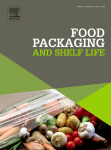
Food Packaging and Shelf Life
Scope & Guideline
Exploring the intersection of materials science and food quality.
Introduction
Aims and Scopes
- Development of Active Packaging Materials:
The journal emphasizes research on active packaging solutions that integrate antimicrobial agents, antioxidants, and other functional components to prolong the shelf life of food products. - Biopolymer and Sustainable Packaging Solutions:
There is a strong focus on the use of biopolymers derived from natural sources, promoting sustainability in food packaging while ensuring effective barrier properties against environmental factors. - Smart Packaging Technologies:
Research on intelligent packaging systems that include sensors and indicators for monitoring food freshness and quality is a significant area of interest, enabling real-time assessment of food status. - Migration Studies and Food Safety:
The journal addresses concerns related to the migration of substances from packaging materials into food, ensuring compliance with safety regulations and protecting consumer health. - Innovative Preservation Techniques:
The exploration of novel preservation methods, including modified atmosphere packaging and the use of natural extracts, is a consistent theme, contributing to enhanced food quality.
Trending and Emerging
- Integration of Nanotechnology in Packaging:
There is a notable increase in research on nanomaterials for food packaging, enhancing barrier properties and introducing antimicrobial functionalities to improve food safety and shelf life. - Edible and Biodegradable Packaging:
Emerging trends highlight the development of edible packaging materials and biodegradable options that minimize environmental impact while ensuring food safety. - Smart and Intelligent Packaging Systems:
The rise in studies related to smart packaging technologies, including real-time monitoring systems and indicators for freshness, is a significant trend, catering to consumer demand for transparency and quality assurance. - Use of Natural Extracts and Bioactive Compounds:
Research focusing on the incorporation of natural extracts, such as essential oils and plant-based antioxidants, to enhance the functional properties of packaging materials is gaining momentum. - Sustainability in Packaging Design:
Sustainable practices in packaging design, including life cycle assessments and the development of compostable materials, are increasingly prominent in recent publications, reflecting societal demands for eco-friendly solutions.
Declining or Waning
- Conventional Plastic Packaging Materials:
Research focused solely on conventional plastic materials without integrating sustainability or active properties is decreasing, as the field shifts towards more eco-friendly and innovative alternatives. - Traditional Chemical Preservatives:
Studies emphasizing the use of chemical preservatives in packaging are less frequent, as there is a growing preference for natural preservatives and methods that align with consumer demands for clean-label products. - Single-Use Packaging Solutions:
Research dedicated to single-use packaging without considerations for environmental impact is waning, reflecting a broader industry trend towards sustainability and recyclability.
Similar Journals

Food Hydrocolloids for Health
Advancing Knowledge in Food Science and NutritionFood Hydrocolloids for Health, published by ELSEVIER, stands at the forefront of research in the fields of food science, gastroenterology, nutrition, and pharmaceutical science. With an ISSN of 2667-0259 and an impressive positioning in the academic community, the journal is ranked Q1 in Food Science and Pharmaceutical Science, alongside Q2 rankings in Gastroenterology and Nutrition and Dietetics as of 2023. This journal serves as a critical platform for disseminating innovative findings related to the health benefits of food hydrocolloids, emphasizing their applications and efficacy in nutrition and medicine. Researchers, professionals, and students can access cutting-edge studies that promote the understanding of health outcomes derived from hydrocolloid-based foods. The journal’s international outreach from the Netherlands facilitates a diverse array of contributions, making it essential for those engaged in advancing knowledge within these dynamic disciplines.

Carbohydrate Polymer Technologies and Applications
Exploring the Future of Carbohydrate Polymers and Their ApplicationsCarbohydrate Polymer Technologies and Applications, published by ELSEVIER, is an esteemed open access journal that has been fostering innovation in the field of carbohydrate polymer research since its inception in 2020. With its ISSN 2666-8939, this journal is dedicated to exploring the intersections of analytical chemistry, biochemistry, biotechnology, and materials science, making significant contributions to our understanding of carbohydrate polymers and their diverse applications across various industries. Notably, it has attained a prominent position in various categories, reflecting its quality and impact: ranked Q1 in Analytical Chemistry, Biotechnology, and several Materials Science disciplines, while maintaining strong positions in the Q2 and other quartiles. Additionally, with impressive Scopus rankings—14th in Chemistry (miscellaneous) and 23rd in Analytical Chemistry—it stands at the forefront of scholarly dialogue in these areas, appealing to researchers, professionals, and students alike. The journal's commitment to open access facilitates wider dissemination of knowledge and enhances collaborative research, solidifying its role as a pivotal resource for advancing carbohydrate polymer technologies.
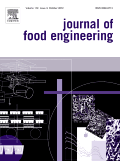
JOURNAL OF FOOD ENGINEERING
Elevating industry standards through rigorous scientific exploration.JOURNAL OF FOOD ENGINEERING, published by ELSEVIER SCI LTD, stands as a leading platform for innovative research within the realm of food science, focusing on the engineering principles applied to food production and processing. With an impressive impact factor reflective of its significance in the field, the journal boasts a Q1 ranking in Food Science and ranks #23 out of 389 in Agricultural and Biological Sciences according to Scopus metrics, placing it in the 94th percentile among its peers. Since its inception in 1982, the journal has aimed to disseminate high-quality, peer-reviewed research that informs and shapes industry practices and academic explorations. Although it does not currently offer an open access option, the journal is dedicated to fostering knowledge and innovation through rigorous editorial standards and a commitment to covering a broad range of topics related to food engineering. Researchers, professionals, and students alike will find the journal an invaluable resource for advancing their understanding of the scientific and technological facets of food systems.
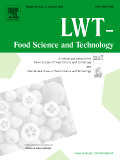
LWT-FOOD SCIENCE AND TECHNOLOGY
Bridging the gap between research and industry.LWT - Food Science and Technology is a premier academic journal published by Elsevier, specializing in the multifaceted fields of food science and technology. With a distinguished presence since its inception in 1973, this journal has evolved to become a vital resource for researchers and professionals aiming to advance knowledge in food safety, preservation, processing, and sensory analysis. Currently ranked in the Q1 quartile of food science journals, it holds an impressive Scopus ranking of 22 out of 389 in the Agricultural and Biological Sciences category, placing it in the 94th percentile. While certain articles may be available via subscription, LWT is committed to disseminating cutting-edge research that enhances food quality and innovation. This journal not only serves as a critical platform for the exchange of scientific ideas but also addresses contemporary challenges in food technology, ensuring that it remains essential for scholars, industry professionals, and students alike seeking to contribute to and stay abreast of advancements in the field.
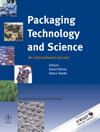
PACKAGING TECHNOLOGY AND SCIENCE
Driving Sustainable Progress in Packaging TechnologyPACKAGING TECHNOLOGY AND SCIENCE, published by Wiley, is a leading journal in the fields of packaging technology, materials science, and mechanical engineering. With a dedicated focus on innovative research and advancements in packaging materials and methodologies, the journal has made significant contributions since its inception in 1988. It holds a distinguished position as a Q2 journal in multiple disciplines, including Chemistry, Materials Science, and Mechanical Engineering, reflecting its high impact and scholarly influence. Although not an Open Access publication, it reaches a broad audience through its rigorous peer-review process and commitment to disseminating critical findings in packaging research. Researchers, professionals, and students alike benefit from the journal’s rich content that encourages interdisciplinary collaboration and the exploration of sustainable packaging solutions. For those seeking to remain at the forefront of packaging technology and science, this journal serves as an essential resource for fostering innovation and addressing the evolving challenges within the industry.

Food Engineering Reviews
Fostering Collaboration among Scholars and Industry Experts.Food Engineering Reviews is a prestigious journal published by SPRINGER, dedicated to advancing the field of food engineering through comprehensive review articles that synthesize current research and innovative practices. With an ISSN of 1866-7910 and an E-ISSN of 1866-7929, this journal serves as a vital resource for researchers, professionals, and students interested in the intricacies of food processing, preservation, and engineering techniques. Notably, the journal holds an impressive Q1 ranking in the category of Industrial and Manufacturing Engineering as of 2023, and it is positioned in the 94th percentile within its field according to Scopus rankings, highlighting its significance within the academic community. Although it does not offer open access, the rigorous content published in the journal from its inception in 2009 through to 2024 plays a crucial role in shaping practices that promote efficiency and sustainability in food engineering. The journal aims to foster knowledge exchange among scholars and industry experts, ensuring that emerging trends and foundational research are accessible to those striving towards excellence in food technology.

Applied Food Research
Bridging Academia and Industry in Food ScienceApplied Food Research, published by Elsevier, is an esteemed journal that plays a critical role in advancing the field of Food Science. With an ISSN of 2772-5022, the journal has established itself as a premier outlet for high-quality research, achieving a commendable Q1 ranking in the 2023 Food Science category and a 63rd percentile in Scopus rankings for Agricultural and Biological Sciences. Covering a diverse range of topics from food safety to innovative processing techniques, Applied Food Research seeks to publish pioneering studies that enhance our understanding of food systems and contribute to broader discussions on sustainability and nutrition. As it converges on its fourth year of publication, researchers, professionals, and students alike are encouraged to engage with its content through various open access options, ensuring widespread dissemination of knowledge in a field that is vital to global health and well-being. Operating out of Amsterdam, Netherlands, this journal is poised to be an indispensable resource for anyone dedicated to making significant contributions in the domain of food science.
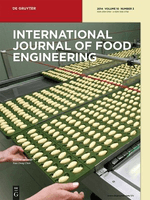
International Journal of Food Engineering
Elevating Food Systems with Cutting-Edge ResearchThe International Journal of Food Engineering, published by WALTER DE GRUYTER GMBH, serves as a pivotal platform for cutting-edge research in the field of food engineering. With an ISSN of 2194-5764 and an E-ISSN of 1556-3758, this journal focuses on innovative technologies, production processes, and quality control within food systems. Located in Germany, the journal has gained notable recognition, as reflected in its Scopus rankings, which place it within the 61st percentile in miscellaneous engineering and the 50th percentile in food science. Although it operates under a traditional access model, the journal's striking category quartiles signify its importance: achieving Q2 in Engineering and Q3 in both Biotechnology and Food Science in 2023. By fostering interdisciplinary research, the International Journal of Food Engineering aims to connect scientists, engineers, and industry professionals, ultimately contributing to advancements in food safety, sustainability, and nutrition. Join a vibrant community of experts driving innovation and addressing global food challenges through your contributions to this esteemed journal.
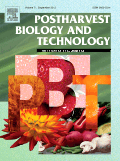
POSTHARVEST BIOLOGY AND TECHNOLOGY
Unlocking the Secrets of Postharvest ExcellencePOSTHARVEST BIOLOGY AND TECHNOLOGY is a leading journal published by Elsevier, focusing on groundbreaking research in the fields of Agronomy, Food Science, and Horticulture. With an impressive impact factor and quartile rankings of Q1 in 2023 across all three disciplines, it is recognized for its significant contributions to enhancing postharvest processes and technologies. The journal offers a platform for multidisciplinary exchange, welcoming studies that explore innovative methods to improve food quality, shelf life, and safety. Researchers and practitioners alike will find valuable insights in its extensive archives, which encompass studies from 1991 to 2024. While it is not an open-access journal, subscribers gain exclusive access to high-impact articles and critical reviews that facilitate advancements in the sector. Based in the Netherlands, at Radarweg 29, Amsterdam, this esteemed publication is essential for professionals who aim to stay at the forefront of postharvest biology and technology.

Journal of Future Foods
Connecting researchers to shape the future of food.Welcome to the Journal of Future Foods, a prominent peer-reviewed publication dedicated to advancing knowledge and innovation within the realms of Agricultural and Biological Sciences, Food Science, and Nutrition and Dietetics. Published by KEAI PUBLISHING LTD in China, this journal has rapidly achieved a distinguished reputation, reflected in its impressive Q1 category ranking for both Agricultural and Biological Sciences and Food Science, along with a strong standing in Nutrition and Dietetics. The journal, which spans the period from 2021 to 2025, is committed to fostering interdisciplinary research that addresses the challenges and opportunities presented by the future of food. With a focus on open access, the Journal of Future Foods aims to disseminate crucial findings and foster collaborative dialogue among researchers, professionals, and students alike. By submitting your work, you not only contribute to cutting-edge advancements in the field but also join a vibrant community engaged in redefining the future of food systems.